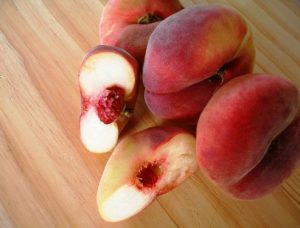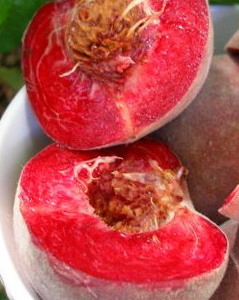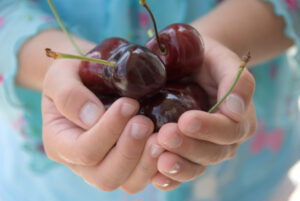
Virgil Evetts
And as we bid a fond adieu to another summer (technically speaking anyway, still plenty hot around my neck of the woods), the final flurry of fruitfulness arrives on shop shelves. Among the season’s last orders are some of its very finest, including my all-time favourite summer fruit- the Black Boy peach.
However great this fruit might be (and believe me, it is), there’s no getting away from the fact that its name is seriously off, and harks back to an earlier, and alarmingly bigoted, age. Even more cringingly, the fruit does not exist under that name anywhere else in the world; in fact it barely exists anywhere else, full stop. The Black Boy, hereafter known as the red-fleshed peach, is (in spite of a lucrative cult following in foodie circles) very rare in cultivation. It’s not a hybrid of a peach and plum as some have suggested (although such hybrids do exist), but a natural mutation of a white-fleshed peach, selected and propagated in France, several centuries ago. The infinitely preferable French moniker, Pêche de Vigne, translates as ‘vineyard peach’ and refers to the old French habit of growing the trees in vineyards, as pest and disease indicators. Rosaceous plants (roses, stone fruit, pip fruit, brambles etc) are susceptible to many of the same undesirables as grapes, and are often grown alongside vines to help vintners identify problems early. Obviously the French never waste an opportunity to eat well, and made damn sure that their sacrificial trees bore the very best fruit.
How this obscure fruit made its way to New Zealand, and practically nowhere else in the world, is more of a mystery. At my most romantic I like to attribute its arrival to the efforts of 19th century French settler to Akaroa or similar, but the truth is probably far less interesting. Back in the golden, and regularly disastrous, days before the notion of bio-security existed, keen nurserymen could stroll off the ships with cuttings of whatever took their fancy under their arms, or a brace of monkeys on their shoulders for that matter.
The red-fleshed peach, or Black Boy if you must, is very much a substance-over-style sort of affair. Put simply, it’s a bit of a munter. Although typically peach-shaped, the skin is of a sort of clotted mauve colour, off-set by a pelt of thick and rather gloomy greyish fuzz. It’s really no wonder that supermarket produce buyers have shunned them so assiduously until quite recently. However, to anyone bold enough to plough on past its ‘face for radio’ exterior, what lies beneath is just about as rewarding as fruit eating ever gets. Dense yet burstingly tender crimson flesh gives way to indelible juiciness, and a flavour combining the finer points of plum, peach and the richest red wine. The fragrance is heady, complex and intoxicating peachy. I know I’m prone to throwing around hyperbole with gay abandon, but if anything I’m probably underselling this peach.
My Grandmother used to bottle Black Boys every year (taken out of context that is one disturbing line!), and a jar or two nearly always made its way up to us in Auckland. These were treated with great reverence – the fruit being so painfully seasonal – and were carefully rationed out as an ice-cream accompaniment, or used in exquisite fruit tarts. Given a moment alone in the kitchen I would drink the velvety, sanguine syrup straight from the jar, leaving my lips treacherously stained. In addition to standard preserving Black Boys make a rather fabulous fruit paste too, and, if you happen to have enough peaches to justify the effort, can be squeezed and rendered down into peach nectar par excellence. French juice and jam masters Allain Milliat produce Pêche de Vigne nectar, and while very, very good it’s really not a patch on homemade. This ambrosial stuff can be used to show-stopping success in Black Boy Bellini’s. With just a drop or 2 of cassis, and a very decent measure of Prosecco or Champagne, this little number is one of the reasons I could never be a long-haul teetotaller.

Also in the shops right now, and a nice contrast to the Black Boy, is the bizarre and beguiling Flatto peach. This relative newcomer to the local stone-fruit scene is most notable for its seriously tacky name, and strange, seemingly mutated looks which have led some to mutter quietly about genetic modification. In reality, China flat, Doughnut or Saturn peaches (as they are known overseas) have been cultivated for over two hundred years in China, and many decades in North America and continental Europe. Flat peaches are almost exclusively white-fleshed, and when properly tree-ripened are juicy, luscious and wonderfully fragrant. Unusually for peaches, they develop sweetness long before the flesh softens, meaning they can be picked, sold and eaten while still relatively hard and unripe. This quirk of the fruit’s unique chemistry imparts an extraordinary shelf life, making it a produce manager’s dream. Neither this apparent advantage, nor the peach’s lunch-box-friendly shape really interests me; I only care that at its best and ripest it tastes really, really good. It’s worth any amount of ire from your fruiterer to find the ripe ones via the squeeze test.
In my occasionally humble (but mostly smug) opinion, the best way with the best produce is invariably the simplest – and peaches are no exception. Almost every restaurant in Italy features macedonia di frutti di pesca on their summer dessert menu, and it takes about one mouthful to work out why – it’s a true revelation. Despite the Balkan suggestiveness of the name, it really just means macerated (in sugar and grappa) and/or mixed peaches.
Macedonia di frutti di pesca
Peel and chop equal quantities of Black boy and Flatto peaches (actually any tree-ripened peaches or nectarine will do) into eighths. Sprinkle with a tablespoon of icing sugar and half a tablespoon of grappa or brandy per peach. Toss together and refrigerate for at least 2 hours. Serve with fresh cream or mascarpone, and a scattering of roughly broken crisp amaretti biscuits. This sounds almost pedestrian, I know, but is to my mind the most respectful, nay reverential, treatment of peaches ever – apart from sun-warmed and straight off the tree.
For those with room and ambition to grown their own, Black Boy trees are available through most garden centres and nurseries from late autumn until spring. They seem to perform better in some regions than others, but as with all peaches, should fruit at least modestly in all but the coldest parts of the country. Flatto trees are available to the home gardeners for the first time this year from garden centres. Supplies will almost certainly be limited, so don’t mess about.
What are your favourite ways with summer stonefruit?
[homepageimage /homepageimage]
/homepageimage]
[smallimage /smallimage]
/smallimage]



Oh I do love your prose and in praise of the Blackboy peach, 2 of which I have awaiting their plot.
The grayish fuzz I think today gives it a distinctive stand-out from the crowd but also tempts their artist in me to raise to the tempting challenge that the subtleties provide.
Perhaps the French nuns who settled their convent up alongside the Whangarei River could have spirited the fruit stock out.
J’aime tantement Pêche de Vigne:-)
Hi. I just came across this while looking for an alternative name for BB peaches as I too cringe whenever I use that name. Between ourselves and other family members there are usually a good quantity to go round, but do require dealing with promptly. “Red fleshed peaches” is a bit of a mouthful (perhaps in every way, or is it just that I’ve been trying to improve my cryptic crosswording during lockdown?) but I will try and refer to them such from now on!
Hi to shed light on how the black boy peach got here it was bought back from the USA by my grandfathers Aunt Annie Rennie AKA the original Aunt Tui. She was New Zealands first home science graduate and had a radio show and wrote cook books under the name Aunt Tui long before Tui Flower.
my “Black Boy” peach is self germinated from within a compost bin, I have had it 3 years and this is its second year fruiting and it is laden
Can you tell me where I can buy blackboy peaches (not trees) the fruit.
A far better & appropriate name is one that a colleague gave them in the early 1990s – Ruby Reds. My 5 trees in coastal north Otago are laden & ripening – drooling delicious delights!
I note your intention to use “red fleshed peach” rather than black boy , I think this is dumb !.obviously you do also, as you continue to use “black boy” such excellent lip service.
I have one of these trees in Canada, on the Gulf Islands. A New Zealand friend posted me ten pits some years ago, and using a crude layering technique, one sprouted and is just this year, producing its first fruit!
I would seriously adore for someone to ship me some pips to start. I purchased a BB tree from a nursery a couple years ago, just before we got the wettest Spring on record around here. My new tree apparently drowned.
At a local food swap, I picked up some Black Boy stones and was told that they grow readily. I haven’t sown mine yet. And yes, they are seriously delish!
Hi there! I’m a visitor to New Zealand from the states and stumbled upon some black boy peaches at a small farmer’s market in Tauranga, to my utmost delight! I love them! I’d love to plant a couple of these trees in my little orchard in Nebraska. Do you have any clue of whether or not I might be able to buy trees in the states? Thank you for the wonderful expose of this delightful little fruit.
Rainforest Nursery of California had them, but is currently sold out.
I stand, looking at my satisfying harvest of the anachronistically appelated black boy peaches, wondering as a novice to the art how one goes about bottling. New technology is employed to seach for instructions on a technique employed by those who would not have batted an eyelid at the name of these peaches. I come across your post and am diverted by the stunning turn of phrase as you describe this marvellous fruit. Thank you for your eloquently worded homage; I set about my task with a smile on my face.
I have left NZ for 28 years, we had a tree in our back yard how I miss the blackboy peach, the birds never ate the fruit just our naughty neighbours. I live in Australia now wish someone could grow the tree hear and give me a seed pleaseee
“Black” refers to dark red coloring – ie, Black Prince and Black Krim tomatoes; “Boy” is sometimes used for fruiting plants – the combination doesn’t have any intentional racial overtones.
Peaches do not reproduce true by seed, so a pit from one of these trees could produce something very different. The one variety I can find in the US looks similar in the few photos I can find:
http://articles.latimes.com/2011/aug/25/food/la-fo-market-watch-20110825
Black Boys will produce true from seed, fruiting 3-5 years after planting. My pit came from fruit where someone did this. And my fruit seem identical to other Black Boys……
What dietary properties are found in black boy peaches. We have a tree and love them. I’m thinking about the claim for “super foods” found in blueberries, strawberries, etc. I can’t find anything for these gorgeous fruit.
Thanks
I would say they are a strong candidate for the admittedly rather dubious ‘super food’ title. Assuming they are coloured by the same family of pigments found in most other red fruits (highly likely) they probably have strong antioxidant properties, aside of the usually high fibre and vitamin content of peaches.
I know its a long shot, but I would love some black boy stones. We dont have this type of peach here in the USA and I would pay you for them…
We have only been in NZ 14 weeks, purchased 1 acre property with lots of different fruits. One being Black boy peaches, we have two trees heavy with fruit. We have been selling at the gate, today most peaches decided to fall so we also picked as well. Bees surprisingly made holes in the fruits quickly, never seen that before. I wondered if they make red honey from this.
So late afternoon saw us bottling and freezing some for ourselves before they all get sold. I found that putting them in a steamer for just 15 seconds them putting in cold water to stop them further cooking,however drain just as quickly, this has the skins sliding off easily. I then simmer the skins for a few minutes to get the wonderful ruby red colour, strain and make my syrup with this.
Thanks for the info on France, and your site is very informative.
I have a blackboy peach tree and for the first time in the 6 years since I planted it its loaded!(normally the wood pigeons get them, here on the west coast) Yummy! But now they are starting to drop and Im looking for reciepes for them-any suggestions?
Lucky you for finding black boys – haven’t seen any around this season as yet though always on the lookout. We used to have a tree in our back garden in Christchurch in the ’70’s and I’m still dreaming about them!!
Black boy peaches were known as such because from a distance, they look black, especially sitting in the tree on a bright summer day. Sun warmed and straight from the tree is definitely the way to eat them
Black Boy peaches are the only peaches for me!
I have just tried my first black boy peaches – very nice, juicy and full of flavour. They are pretty ugly though from the outside, quite hideous really and my husband does not fancy them at all.
Yes, deliberate mistake… Well spotted, you!
Note to self: Punish proof reader with extreme prejudice.
I win! I have spotted your deliberate mistake, Virgil. Assiduously, not acidulously.